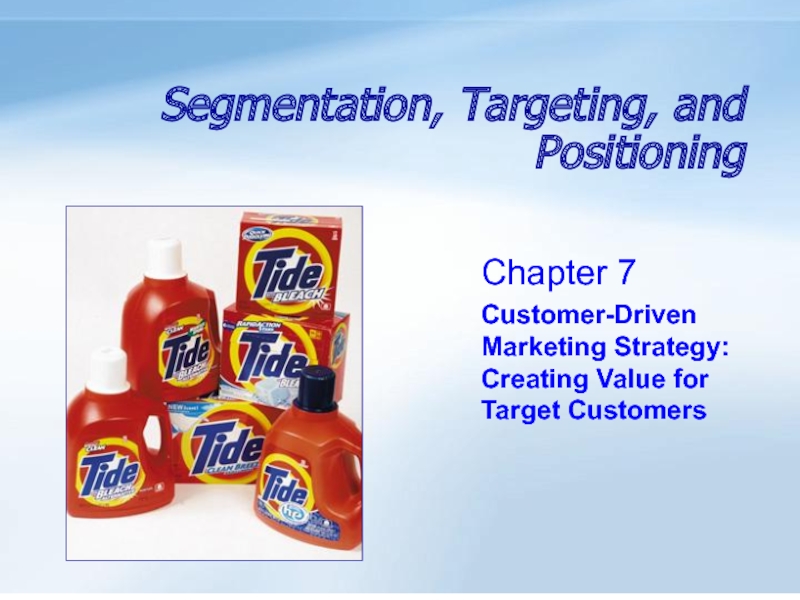Разделы презентаций
- Разное
- Английский язык
- Астрономия
- Алгебра
- Биология
- География
- Геометрия
- Детские презентации
- Информатика
- История
- Литература
- Математика
- Медицина
- Менеджмент
- Музыка
- МХК
- Немецкий язык
- ОБЖ
- Обществознание
- Окружающий мир
- Педагогика
- Русский язык
- Технология
- Физика
- Философия
- Химия
- Шаблоны, картинки для презентаций
- Экология
- Экономика
- Юриспруденция
Segmentation, Targeting, and Positioning
Содержание
- 1. Segmentation, Targeting, and Positioning
- 2. 7- ObjectivesBe able to define the three
- 3. 7- Procter and Gamble in KazakhstanList
- 4. 7- Procter and Gamble in Kazakhstan Describe the
- 5. 7- Sells multiple brands within the same
- 6. 7- What is Market Segmentation? Dividing a market
- 7. 7- Decide on value propositionSelect customers to
- 8. 7- The Process of Market Segmentation and Target MarketingAdults Teens KidsAge Kids
- 9. 7- Segmentation of Airline PassengersSource: Peter Doyle (1998), Marketing Management and Strategy, Prentice Hall Europe, p.67.
- 10. 7- Market SegmentationSegmenting Consumer MarketsSegmenting Business MarketsSegmenting
- 11. 7- Market SegmentationGeographic Segmentation VariablesCity or Metro SizeNeighborhoodDensityClimateWorld Region or CountryCountry RegionStateCity
- 12. 7- Geographical climate is a legitimate means
- 13. 7- Market SegmentationSegmenting Consumer MarketsSegmenting Business MarketsSegmenting
- 14. 7- Market SegmentationDemographic Segmentation VariablesAgeGenderFamily sizeFamily life cycleIncomeRaceOccupationEducationReligionGenerationNationality
- 15. 7- What type of demographic segmentation is reflected by this ad?
- 16. 7- Household life cycle segmentationBased on: Gilly,
- 17. 7- Market SegmentationSegmenting Consumer MarketsSegmenting Business MarketsSegmenting
- 18. 7- Swatch targets those with an active lifestyle
- 19. 7- Market SegmentationSegmenting Consumer MarketsSegmenting Business MarketsSegmenting
- 20. 7- Market SegmentationBehavioral Segmentation VariablesOccasionsBenefitsUser StatusUser RatesLoyalty StatusReadiness StageAttitude Toward the Product
- 21. 7- Benefit Segmentation: Champion Athletic Wear“Fit
- 22. 7- Mobil’s Benefit Segmentation: enhanced profitsRoad
- 23. 7- Checkout Direct offers retailers & manufacturers
- 24. 7- Heavy and Light Users of Common
- 25. 7- Market SegmentationSegmenting Consumer MarketsSegmenting Business MarketsSegmenting
- 26. 7- What is the base for segmentation?Cosmo
- 27. 7- Market SegmentationSegmenting Consumer MarketsSegmenting Business MarketsSegmenting
- 28. 7- Market SegmentationSegmenting Consumer MarketsSegmenting Business MarketsSegmenting
- 29. 7- Market SegmentationSegmenting Consumer MarketsSegmenting Business MarketsSegmenting
- 30. 7- Decide on value propositionSelect customers to
- 31. 7- Target MarketingEvaluating Market SegmentsSegment size and
- 32. 7- Figure 7-2: Target Marketing Strategies
- 33. 7- Target MarketingChoosing a Target-Marketing Strategy
- 34. 7- Nokia Video1 Why has segmentation been
- 35. 7- Decide on value propositionSelect customers to
- 36. 7- Positioning: What is it?Segmentation + DifferentiationConsumer Competitive analysis analysisTo Whom? What?
- 37. 7- PositioningPositioning:The place the product occupies in
- 38. 7- PriceQualityHighLowHighLowИрбисКарагандинскоеШымкенсткоеHeinekenБалтикаAmstelCorona
- 39. 7- Differentiating and PositioningDifferentiation - act of
- 40. 7- Positioning consists of1. Identifying possible
- 41. 7- Identifying Possible Competitive AdvantagesPositioning begins with
- 42. 7- Differentiation Dimensions
- 43. 7- Product Differentiation Variables
- 44. 7- Porsche is positioned on the basis of performance and freedom.
- 45. 7- PositioningChoosing a Positioning Strategy:Choosing the right
- 46. 7- Perceptual MapPerceptual Map - а means
- 47. 7- Consumer Perception in 1982 and GM goals for 1990PontiacOldsmobileCadillacBuickChevroletFamily/ConservativePersonal/expressiveHigh priceLow priceSaturn
- 48. 7- PositioningCriteria for Meaningful DifferencesImportantSuperiorPreemptiveDistinctiveCommunicableAffordableProfitable
- 49. 7- Which Difference to Promote?Important: The difference
- 50. 7- Figure 7-4: Possible Value Propositions Value
- 51. 7- Possible Value Propositions LexusStart upsDellRolex1 dollar store, Southwest
- 52. 7- Positioning Strategies Positioning by attribute: Associating a
- 53. 7- Positioning by attribute: Associating a product with a particular feature: colour, size, design
- 54. 7- Positioning by benefit: Associating a product with a special customer benefit: quality, performance
- 55. 7- Positioning by quality/price: Using price
- 56. 7- Positioning by use/application: Associating the product with a use or application
- 57. 7- Positioning by user: Associating a product with a user or class of user
- 58. 7- Positioning by product category: Associating the product with others in a similar product class
- 59. 7- Positioning by competitor: Identifying the
- 60. 7- Positioning Strategies - Examples
- 61. 7-
- 62. 7- Choosing a Positioning Strategy:Developing a positioning
- 63. 7- PositioningChoosing a Positioning Strategy:Communicating and delivering
- 64. 7- Communicating & Delivering Chosen PositionIf a
- 65. 7- Decide on value propositionSelect customers to
- 66. Скачать презентанцию
Слайды и текст этой презентации
Слайд 1Segmentation, Targeting, and Positioning
Chapter 7
Customer-Driven Marketing Strategy: Creating Value for
Target Customers
Слайд 27-
Objectives
Be able to define the three steps of target
marketing: market segmentation, target marketing, and market positioning.
Understand the major
bases for segmenting consumer and business markets.Know how companies identify attractive market segments and how they choose a target marketing strategy.
Comprehend how companies position their products for maximum competitive advantage.
Слайд 47-
Procter and Gamble in Kazakhstan
Describe the typical consumer for
every product
Secret, Old spice
Ariel, Tide, Mif
Wash&Go, Head&Shoulders, Pantene
Camay, Safeguard
Слайд 57-
Sells multiple brands within the same product category for
a variety of products
Ariel, Tide, Mif
Brands feature a different mix
of benefits and appeal to different segmentsWash&Go, Head&Shoulders, Pantene
Has also identified different niches within certain segments
Tide offers seven different product formulations to serve different niches’ needs
c
Procter & Gamble
Слайд 67-
What is Market Segmentation?
Dividing a market into smaller groups
with distinct needs, characteristics, or behavior who might require separate
products or marketing mixesEx.
Слайд 77-
Decide on value proposition
Select customers to serve
Figure 7-1:
Steps
in Market
Segmentation, Targeting, and Positioning
Segmentation
Divide the total market
into
smaller segmentsTargeting
Select segment(s)
to enter
Differentiation
Differentiate the market
offering to create superior
customer value
Positioning
Position the market
offering in the minds of
target customers
Create
value for
targeted
customers
Слайд 97-
Segmentation of Airline Passengers
Source: Peter Doyle (1998), Marketing Management
and Strategy, Prentice Hall Europe, p.67.
Слайд 107-
Market Segmentation
Segmenting Consumer Markets
Segmenting Business Markets
Segmenting International Markets
Requirements for
Effective Segmentation
Geographical segmentation
Marketing mixes are
customized geographically
Demographic segmentation
Psychographic segmentation
Behavioral segmentation
Using
multiple segmentation variablesKey Topics
Слайд 117-
Market Segmentation
Geographic
Segmentation Variables
City or
Metro Size
Neighborhood
Density
Climate
World Region or
Country
Country Region
State
City
Слайд 127-
Geographical climate is a legitimate means of segmentation for
many products or services.
Name several examples of products for which
need (and demand) would vary on a geographical basis. Discussion Question
Слайд 137-
Market Segmentation
Segmenting Consumer Markets
Segmenting Business Markets
Segmenting International Markets
Requirements for
Effective Segmentation
Geographical segments
Demographic segmentation
Most popular type
Demographics are closely related to
needs, wants and usage ratesPsychographic segmentation
Behavioral segmentation
Using multiple segmentation variables
Key Topics
Слайд 147-
Market Segmentation
Demographic
Segmentation Variables
Age
Gender
Family size
Family life cycle
Income
Race
Occupation
Education
Religion
Generation
Nationality
Слайд 167-
Household life cycle segmentation
Based on: Gilly, M. and Enis,
B. (1982), ‘Recycling the Family Life Cycle: A Proposal for
Redefinition’, in Mitchell, A. (ed.), Advances in Consumer Research, 9, Association for Consumer Research, Ann Arbor, MI, 271–6Слайд 177-
Market Segmentation
Segmenting Consumer Markets
Segmenting Business Markets
Segmenting International Markets
Requirements for
Effective Segmentation
Geographic segments
Demographic segmentation
Psychographic segmentation
Lifestyle, social class, and personality-based
segmentationBehavioral segmentation
Using multiple segmentation variables
Key Topics
Слайд 197-
Market Segmentation
Segmenting Consumer Markets
Segmenting Business Markets
Segmenting International Markets
Requirements for
Effective Segmentation
Geographic segments
Demographic segmentation
Psychographic segmentation
Behavioral segmentation
Typically done first
Using multiple
segmentation variablesKey Topics
Слайд 207-
Market Segmentation
Behavioral
Segmentation Variables
Occasions
Benefits
User Status
User Rates
Loyalty Status
Readiness Stage
Attitude Toward
the Product
Слайд 217-
Benefit Segmentation:
Champion Athletic Wear
“Fit and polish” look for
function and style
“Serious sports competitors”
performance and function
“Value-seeking moms’
Durability
and valueСлайд 227-
Mobil’s Benefit Segmentation:
enhanced profits
Road Warriors 16%
Premium products and
quality service
Generation F 27%
Fast fuel, Fast service, Fast food
True
Blues 16%Branded products and reliable service
Home Bodies 21%
Convenience
Price Shoppers 20%
Low price
Mobil charged $0.02 per gallon more,
But sales increased by 20-25%
Слайд 237-
Checkout Direct offers retailers & manufacturers an excellent method
of reaching segments of heavy users, as well as users
of the direct competition.Слайд 247-
Heavy and Light Users of
Common Consumer Products
HEAVY USERS
75%
71%
Soups
and
detergents
LIGHT USERS
25%
29%
79%
75%
13%
21%
25%
83%
83%
17%
5%
17%
87%
Toilet tissue
PRODUCT
Shampoo
81%
Paper towels
Cake mix
19%
Cola
95%
Beer
Dog food
Bourbon
Total consumption
is high among heavy users (PARETO RULE)Слайд 257-
Market Segmentation
Segmenting Consumer Markets
Segmenting Business Markets
Segmenting International Markets
Requirements for
Effective Segmentation
Geographic segments
Demographic segmentation
Psychographic segmentation
Behavioral segmentation
Using multiple segmentation variables
Key
TopicsСлайд 267-
What is the base for segmentation?
Cosmo magazine
Prada clothes
Advanced Auditing book
Kinder Surprise
Axe deodorant
No pork inside sausages
Wedding Dress
Hotel chain
customizes rooms according to the location of its hotelsA quick-dry nail polish
ABBA songs
Слайд 277-
Market Segmentation
Segmenting Consumer Markets
Segmenting Business Markets
Segmenting International Markets
Requirements for
Effective Segmentation
Demographic segmentation
Industry, company size, location
Operating variables
Technology, usage status, customer
capabilitiesPurchasing approaches
Situational factors
Urgency, specific application, size of order
Personal characteristics
Buyer-seller similarity, attitudes toward risk, loyalty
Key Topics
Слайд 287-
Market Segmentation
Segmenting Consumer Markets
Segmenting Business Markets
Segmenting International Markets
Requirements for
Effective Segmentation
Geographic segmentation
Location or region
Economic factors
Population income or level of
economic developmentPolitical and legal factors
Type / stability of government, monetary regulations, amount of bureaucracy, etc.
Cultural factors
Language, religion, values, attitudes, customs, behavioral patterns
Key Topics
Слайд 297-
Market Segmentation
Segmenting Consumer Markets
Segmenting Business Markets
Segmenting International Markets
Requirements for
Effective Segmentation
Measurable
Size, purchasing power, and profile of segment
Accessible
Can be reached
and served Substantial
Large and profitable enough to serve
Differentiable
Respond differently
Actionable
Effective programs can be developed
Key Topics
Слайд 307-
Decide on value proposition
Select customers to serve
Figure 7-1:
Steps
in Market
Segmentation, Targeting, and Positioning
Segmentation
Divide the total market
into
smaller segmentsTargeting
Select segment(s)
to enter
Differentiation
Differentiate the market
offering to create superior
customer value
Positioning
Position the market
offering in the minds of
target customers
Create
value for
targeted
customers
Слайд 317-
Target Marketing
Evaluating Market Segments
Segment size and growth
Segment structural attractiveness
Level of competition
Substitute products
Power of buyers
Powerful suppliers
Company
objectives and resourcesСлайд 337-
Target Marketing
Choosing a Target-Marketing Strategy
Requires Consideration of:
Company resources
The
degree of product variability
Product’s life-cycle stage
Market variability
Competitors’ marketing strategies
Слайд 347-
Nokia Video
1 Why has segmentation been a successful marketing
strategy for Nokia?
2 Which customer characteristics and segmentation variables are
used by Nokia?3 Identify and describe the segments Nokia markets.
4 What potential new markets could you add to the Nokia markets?
Слайд 357-
Decide on value proposition
Select customers to serve
Figure 7-1:
Steps
in Market
Segmentation, Targeting, and Positioning
Segmentation
Divide the total market
into
smaller segmentsTargeting
Select segment(s)
to enter
Differentiation
Differentiate the market
offering to create superior
customer value
Positioning
Position the market
offering in the minds of
target customers
Create
value for
targeted
customers
Слайд 367-
Positioning: What is it?
Segmentation + Differentiation
Consumer Competitive
analysis analysis
To Whom? What?
Слайд 377-
Positioning
Positioning:
The place the product occupies in consumers’ minds relative
to competing products.
Typically defined by consumers on the basis of
important attributes.Слайд 397-
Differentiating and Positioning
Differentiation - act of designing a set
of meaningful differences to distinguish the company’s offering from competitors’
offerings.Differential (competitive) advantage - an attribute of a product or a business that is not currently matched by rival companies or products and is highly desired by target market’s customers
Positioning - process of creating an image for a product in the minds of target customers relative to competing products.
Слайд 407-
Positioning consists of
1. Identifying possible competitive advantages
Product, Service, Personnel, Channel, Image Differentiation
2. Developing a positioning
strategy How many differences to promote and which ones
3. Communicating and delivering the chosen position
Слайд 417-
Identifying Possible
Competitive Advantages
Positioning begins with actually
differentiating the company’s
marketing offer
so that it will give consumers more value
than
competitors offerby offering lower prices than competitors or
by providing more benefits to justify higher prices
Слайд 457-
Positioning
Choosing a Positioning Strategy:
Choosing the right competitive advantage
How
many differences to promote?
Unique selling proposition (USP)
Positioning errors to avoid
Which differences to promote?Слайд 467-
Perceptual Map
Perceptual Map - а means of displaying or
graphing in two dimensions the location of products or brands
in the minds of consumers.Map can show that there are no brands in a particular area, there may be room for a new product.
Research can be conducted to determine what characteristics an “ideal product” would have. If there is no competitive offering in the product space the ideal product would occupy on the map, a market opportunity may exist.
Repositioning. To see how consumers perceive competing products and take actions to try to change the product offering and the image it projects to consumers.
Слайд 477-
Consumer Perception in 1982
and GM goals for 1990
Pontiac
Oldsmobile
Cadillac
Buick
Chevrolet
Family/
Conservative
Personal/
expressive
High
price
Low price
Saturn
Слайд 487-
Positioning
Criteria for Meaningful Differences
Important
Superior
Preemptive
Distinctive
Communicable
Affordable
Profitable
Слайд 497-
Which Difference to Promote?
Important: The difference delivers a highly
valued benefit to a sufficient number of buyers
Distinctive: The
difference either isn’t offered by others or is offered in a more distinctive way by the companySuperior: The difference is superior to other ways of obtaining the same benefit
Communicable: The difference is communicable and visible to buyers
Pre-emptive: The difference cannot be easily copied by competitors
Affordable: The buyer can afford to pay for the difference
Profitable: The company will find it profitable to introduce the difference
Слайд 507-
Figure 7-4:
Possible Value Propositions
Value proposition
is the full
mix of benefits upon which a brand is positioned
Слайд 527-
Positioning Strategies
Positioning by attribute: Associating a product with a
particular feature
Positioning by benefit: Associating a product with a special
customer benefit Positioning by quality/price: Using price as a cue to higher quality, with higher quality being reflected in more features and/or services
Positioning by use/application: Associating the product with a use or application
Positioning by user: Associating a product with a user or class of user
Positioning by product category: Associating the product with others in a similar product class
Positioning by competitor: Identifying the product by using a competitor as a reference point
Слайд 537-
Positioning by attribute: Associating a product with a particular
feature: colour, size, design
Слайд 547-
Positioning by benefit: Associating a product with a special
customer benefit:
quality, performance
Слайд 557-
Positioning by quality/price:
Using price as a cue to
higher quality, with higher quality being reflected in more features
and/or servicesСлайд 587-
Positioning by product category: Associating the product with others
in a similar product class
Слайд 597-
Positioning by competitor:
Identifying the product by using a
competitor as a reference point: 7UP - uncola
Слайд 627-
Choosing a Positioning Strategy:
Developing a positioning statement
Positioning statement states
the product’s membership in a category and then shows its
point-of-difference from other members of the category.To (target segment and need) our (brand) is (concept) that (point-of-difference)
“To busy, mobile professionals who need to always be in the loop, BlackBerry is a wireless connectivity solution that allows you to stay connected to data, people, and resources while on the go, easily and reliably – more so than competing technologies”
Слайд 637-
Positioning
Choosing a Positioning Strategy:
Communicating and delivering the chosen position
Entire marketing mix must support the
chosen strategy
May
require changes to the product,
pricing, distribution or promotion.Слайд 647-
Communicating & Delivering Chosen Position
If a company builds
a position on
offering superior value (Ex. better quality and
service) to the target markets
it must then DELIVER that position
produce high-quality products
charge a higher price
distribute through high-class dealers
advertise in high-quality media
hire and train more service people
find retailers who have good reputation for service
develop sales and advertising messages that broadcast its superior service
Слайд 657-
Decide on value proposition
Select customers to serve
Figure 7-1:
Steps
in Market
Segmentation, Targeting, and Positioning
Segmentation
Divide the total market
into
smaller segmentsTargeting
Select segment(s)
to enter
Differentiation
Differentiate the market
offering to create superior
customer value
Positioning
Position the market
offering in the minds of
target customers
Create
value for
targeted
customers




















































































